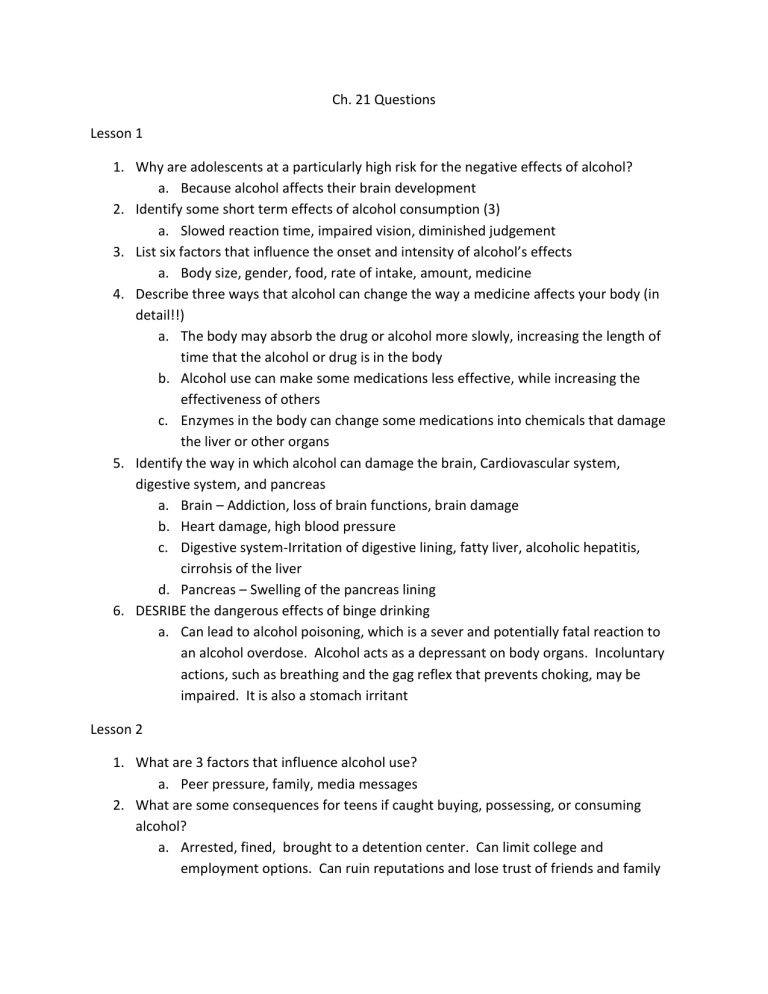Ch. 21 Questions Lesson 1 Why are adolescents at a particularly

Ch. 21 Questions
Lesson 1
1.
Why are adolescents at a particularly high risk for the negative effects of alcohol? a.
Because alcohol affects their brain development
2.
Identify some short term effects of alcohol consumption (3) a.
Slowed reaction time, impaired vision, diminished judgement
3.
List six factors that influence the onset and intensity of alcohol’s effects a.
Body size, gender, food, rate of intake, amount, medicine
4.
Describe three ways that alcohol can change the way a medicine affects your body (in detail!!) a.
The body may absorb the drug or alcohol more slowly, increasing the length of time that the alcohol or drug is in the body b.
Alcohol use can make some medications less effective, while increasing the effectiveness of others c.
Enzymes in the body can change some medications into chemicals that damage the liver or other organs
5.
Identify the way in which alcohol can damage the brain, Cardiovascular system, digestive system, and pancreas a.
Brain – Addiction, loss of brain functions, brain damage b.
Heart damage, high blood pressure c.
Digestive system-Irritation of digestive lining, fatty liver, alcoholic hepatitis, cirrohsis of the liver d.
Pancreas – Swelling of the pancreas lining
6.
DESRIBE the dangerous effects of binge drinking a.
Can lead to alcohol poisoning, which is a sever and potentially fatal reaction to an alcohol overdose. Alcohol acts as a depressant on body organs. Incoluntary actions, such as breathing and the gag reflex that prevents choking, may be impaired. It is also a stomach irritant
Lesson 2
1.
What are 3 factors that influence alcohol use? a.
Peer pressure, family, media messages
2.
What are some consequences for teens if caught buying, possessing, or consuming alcohol? a.
Arrested, fined, brought to a detention center. Can limit college and employment options. Can ruin reputations and lose trust of friends and family
3.
What is the relationship between alcohol and violence for teens? a.
Fights are more likely to break out when alcohol is present. Teens are also more likely to be the victims of violent crimes such as rape, aggravated assault or robbery
4.
Identify the risks faced by a teen who lives in a household in which a family member abuses alcohol a.
Neglect, abuse, social isolation b.
Economic hardship c.
Personal use of alcohol themselves d.
Mental illness or physical problems
5.
List 7 benefits that you will enjoy throughout your life by remaining alcohol free a.
Maintaining a healthy body, Establishing healthy relationships, Making healthy decisions, Avoiding risky behaviors, Avoiding illegal activities, avoiding violence, achieving goals
Lesson 3
1.
Identify ALL of the factors that go into calculating blood alcohol concentration a.
BAC depends on quantity and type of alcohol consumed, rate of consumption, and body size and gender
2.
List some consequences that teens who drink and drive may face a.
Injuries to, or death, to not only the driver but passengers and perhaps others; arrest court appearance and fine, and a police record; severely restricted driving privelages and or immediate confiscation of drivers license; insurance goes up
3.
Why shouldn’t pregnant women use alcohol during their pregnancy a.
Put baby at risk for FAS (fetal alcohol syndrome)
4.
Identify some problems associated with fetal alcohol syndrome (6) a.
Small head and deformities of face, hands, or feet b.
Heart, liver, and kidney defects c.
Vision and hearing problems d.
Central nervous system problems, developmental disabilities, and poor coordination e.
Difficulties with learning and a short attention span f.
Hyperactivity, anxiety, and social withdrawal
5.
List some symptoms of alcoholism (4) a.
Craving, loss of control, physical dependence, tolerance
6.
List the stages of alcoholism (3) a.
Abuse, dependence, addiction
7.
List the stages of recovery from alcoholism (4) a.
Admission, detoxification, counseling, recovery











